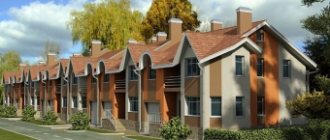How to recognize a house as unsafe is a question asked by owners who want to change their living space to a more comfortable one. But for this, an apartment building must be recognized as unsafe in accordance with the procedure established by law . The Soviet era left us a legacy of housing stock, which is in a deplorable state and is becoming more and more destroyed every year. Over the past 25 years, not much new housing has been built and, as a result, millions of square meters of emergency housing have been created, in which women, children and the elderly live. Many emergency houses are houses without amenities, in which even the toilet is located on the street. Since the beginning of a large-scale federal program for relocation from dilapidated housing, citizens living in unsuitable housing have a chance to improve their living conditions and get comfortable apartments.
Recognition of a house as unsafe and subject to demolition
The recognition of a house as unsafe and subject to demolition is regulated by Decree 47 of the Government of the Russian Federation of January 28, 2006.
In accordance with this resolution, the owners are explained the procedure for submitting documents to recognize a house as unsafe, how to do this and where to submit them. So, if the owner of a premises in an apartment building believes that the house is in a deplorable condition, then he has the right to submit documents to recognize the apartment building as unfit for habitation and in disrepair. In general, no legislative act specifies how many people should submit documents, one or more. If an apartment building is in a condition where no major repairs can help, then the interdepartmental commission is obliged to recognize it as unfit for habitation and in disrepair. The main documents in this case will be a technical passport for an apartment building, which will necessarily indicate the percentage of depreciation of the building, a state housing inspection report and an examination of design and survey work, the conclusions of which should confirm the inappropriateness of major repairs and the unsuitability of people living in the house. Such documents can be submitted either by one home owner or by a group of them. Due to the significant costs of conducting the examination, the best option would be for all interested parties to unite. Many citizens are not aware of their rights and believe that the local administration should recognize the house as unsafe. Of course, if there is a municipal share in the house, then the administration does have this opportunity, but not the obligation. In many regions of the country, prosecutors file lawsuits against local governments in defense of the rights of citizens on the obligation of the administration to initiate the procedure for recognizing houses as unsafe and subject to demolition. This position has significantly increased the number of houses recognized as unsafe throughout the country. But in the pursuit of statistics, the opinions of the citizens themselves, who did not want this, were not taken into account.
What does the owner receive if a residential building is recognized as unsafe and subject to demolition?
If a residential building is recognized as unsafe and subject to demolition, improvement of living conditions can occur in three ways. First, you are waiting for the house to begin to be resettled under the federal program for relocation from dilapidated and dilapidated housing. In this case, you need to check with the local administration whether the house is included in this program. Second, the house is being resettled by the local government at its own expense. And third, you yourself initiate a lawsuit through the court to obtain comfortable living quarters. In this case, you can get a living space with an area no less than what you currently occupy and a number of rooms no less than what is currently in use. You can also change the method of obtaining housing and replace it with cash.
In order to recognize a house as unfit for habitation and in disrepair, the applicant must submit the following documents to the interdepartmental commission for consideration:
- statement;
- expertise;
- State Housing Inspectorate report on the unsatisfactory condition of the house;
- property documents or social tenancy agreement;
- technical certificate.
After submitting these documents, the commission reviews them within 30 days and gives its conclusion. If the commission concludes that a residential building is recognized as unsafe, then local authorities issue a resolution or order recognizing the house as unsafe. This document will be the main document on the path to acquiring new housing. Whether a residential building is subject to demolition or not depends on whether the house is an architectural monument. If so, then such a house cannot be demolished, but must be reconstructed.
What is the difference?
Let's consider the difference between dilapidated and emergency housing stock. In practice, several differences can be distinguished between dilapidated and dilapidated apartment buildings.
| Differences | Dilapidated | Emergency |
| Status | General concept. The law does not establish such a status. | Officially assigned. The local government authority issues a resolution declaring it an emergency and requiring resettlement. |
| Rights and obligations of owners | Common to all owners of apartments in multi-apartment buildings | Right to compensation or alternative housing ownership |
| Rights and obligations of the employer | Common to all tenants under a social tenancy agreement | No need to pay for renting a room |
| Payment of contributions for major repairs | In full | Not required |
| Danger | Load-bearing structures remain reliable | There is a danger of destruction and harm to residents |
| Possibility of obtaining alternative housing | No, only major repairs | Yes, in accordance with the local government resettlement program |
Recognition of an apartment building as unsafe and subject to reconstruction
An apartment building is recognized as unsafe and subject to reconstruction using almost the same mechanism as houses subject to demolition. So why is there a difference in wording when a house is considered unsafe?
But the thing is that residential buildings are recognized as subject to reconstruction if they are architectural monuments. The fact is that if an apartment building is an architectural monument, then it cannot be demolished by law. In this case, the house is recognized as subject to reconstruction, and then all owners are responsible for carrying out reconstruction in it. In fact, for owners of houses living in houses recognized as architectural monuments, the other side of the “coin” occurs after such a residential building is recognized as unsafe. In this case, demolition cannot be carried out, which means it is simply impossible to resettle the house. And then, according to the Housing Code of the Russian Federation, the owners have the obligation to carry out reconstruction in the house at their own expense, in proportion to their share of the property. At such a moment, an overlap occurs. The owners of the house do not know that their house is an architectural monument and are starting the procedure for declaring an apartment building unsafe, not knowing all the consequences. If, nevertheless, it is necessary to recognize an apartment building as unsafe, then another pitfall in this situation will be the costly examination of the house. Since the house is an architectural monument, the examination must be carried out by a certain organization. It must have a separate license for the ability to work with architectural monuments. Accordingly, the cost of the examination will be significantly higher.
How to find out whether the apartment building where you live is an architectural monument or not? Apartment buildings can be architectural monuments of various significance - federal, regional or local. In general, it is enough to write a request to any government agency that is responsible for working with monuments or cultural values and they will give you an answer. You can also find such information on the Internet.
The concept and signs of dilapidated and emergency housing
For those who are not familiar with housing law, it is difficult to distinguish between dilapidated and emergency housing stock. In simple terms, these are residential premises with technical deviations. Neither dilapidated nor emergency housing is suitable for comfortable living . Who would want to live in an apartment where the roof constantly leaks, cracks on the walls, a shaky balcony, the smell of dampness and mold. Usually even repairs don't help.
The law defines the criteria for dilapidated and dilapidated housing - they differ, which we will discuss below.
Dilapidated housing
Today there is no definition in the law of “dilapidated housing”. The term was mentioned in the previous legislative act of the RSFSR in 1983. Nowadays, only the concept of “emergency housing” is used. When talking about dilapidation, we mean a certain middle ground - between new housing and unsuitable for human habitation, i.e. for demolition
Expert opinion
Semyon Frolov
Lawyer. 7 years of experience. Specialization: family, inheritance, housing law.
Dilapidated load-bearing structures of an apartment building (ABC) look worn out. But they continue to perform their functions, for example - the stability of the foundation, the reliability of the walls, roof, and internal ceilings. True, dilapidated buildings still need repairs.
Criteria for recognizing a house as dilapidated:
- structures wear up to 70% - relevant for houses made of stone, brick, and prefabricated panels;
- wear rate up to 65% - for wooden buildings and attics.
One of the main features is the absence of a threat to human life and health . In other words, the house stands firmly on the foundation and does not collapse before our eyes. There is no need to urgently resettle the apartment buildings and allocate new apartments to the residents.
Example:
Residents of the 5-story old building complained about problems with living. It turned out that the house was in disrepair and was going through one renovation after another. The front wall was cracked, the wooden windows were in poor condition, water was flowing from the pipes, and there were cracks in the floor somewhere. At the same time, residents of the apartment complex did not experience problems with heating, electricity and the supply of cold and hot water supplies. A local house inspection commission found no serious violations. The housing was classified as dilapidated buildings - there was no talk of accidents.
Emergency housing
What “emergency housing” means is stated explicitly in the law.
Emergency housing is housing stock classified as unsuitable and subject to demolition in accordance with the order of local authorities
(Clause 2, Clause 1, Article 2 of the Federal Law “On the Fund for Assistance to Housing and Communal Services Reform”).
Starting on January 1, 2021, a program for relocation from unsuitable properties was launched. This includes houses classified as emergency housing in the period from 2012 to 2017. Residents are already waiting their turn to move into new comfortable housing.
Signs of unsafe houses are noted in section III of the Post. Rights No. 47. Let's define them in order:
- critical wear and tear of a residential building - over 70%
- high risk of collapse of the building or its individual parts, for example, load-bearing walls, roof, interfloor partitions, etc.
- location of apartment buildings in dangerous proximity to industrial facilities - threats of fire, explosions, flooding, chemical poisoning;
- being close to mudflows and snow slides, river floods, falling rocks, mountain decompositions, etc.
- exceeding the permissible noise level;
- proximity to main roads or power lines;
- non-compliance with SanPiN standards - dampness, mold.
Living in a dilapidated building poses a threat to its residents. They risk not only their property, but also their health.
However, resettlement does not apply to all residential buildings. If a building has 1-2 floors and there is no sewerage system, this is not a sign of emergency. The situation is similar in five-story buildings, where there is no elevator with a garbage chute.
Which houses are considered unsafe?
Which houses are considered unsafe? An apartment building becomes unsafe only when its status is officially confirmed by a regulatory document of the administration. Recognizing it as an emergency is primarily based on the conclusions of the examination. But before ordering it, you can visually assess for yourself what conclusion will be drawn regarding a particular house.
Of course, if a house, for example, has a roof covering in unsatisfactory condition, then the house is recognized as simply requiring major repairs, but in no case is it considered unfit for habitation. In most cases, the main reason for recognizing a house as unsafe is the physical deterioration of the building. It is expressed in damage to the supporting structures of the building and its foundation. When its reliability and strength are so low that it endangers the life or health of people living in it. Also, houses can be recognized as unsafe if they are located in places where the level of sanitary and epidemiological safety of citizens is at the maximum level of risk for living in it. For example, the level of radiation or electromagnetic radiation is exceeded. In places prone to landslides, mudflows, where power lines run. As well as houses that have been subjected to destruction, after which it is not economically feasible to carry out restoration work in the house.
Examination to recognize a house as unsafe
An examination to recognize a house as unsafe is the main document that is necessary to make a decision on the unsuitability of living in a given apartment building. In order to carry out an examination of the house to determine whether it is dangerous, design and survey work is carried out to identify damage to the load-bearing elements of the house’s structures. If the damage to the above structures is higher than normal, then the conclusion is made that it is unsuitable for living in an apartment building. Most often, houses are recognized as unsafe if the percentage of wear and tear on the house is 70 percent or higher. The authority to conduct an examination is possessed only by an organization with an appropriate license to carry out such work. If the object is an architectural monument, then there must be a separate license to conduct such an examination.
Interdepartmental commission for recognizing a house as unsafe
The interdepartmental commission for recognizing a house as unsafe accepts documents for consideration, checks the stated facts and documents and makes a final decision on recognizing the house as unsafe or may conduct an additional inspection. The period for reviewing documents from the date of application is 30 days. If the conclusion of the interdepartmental commission indicates the conclusions that the house is recognized as unsafe and subject to demolition, then the authority within 30 days issues an order with the appropriate deadlines for the resettlement of citizens. The interdepartmental commission for recognizing a house as unsafe includes representatives of local governments from various departments: Rospotrebnadzor, State Housing Inspectorate and other various structures. The composition of the commission is approved by the regulatory documents of the local government body.
○ Legislation on dilapidated and emergency housing.
This type of housing is dangerous in many ways. In the first place, of course, are the lives of citizens who live in such houses. However, communications, city roads, and residents’ property may also be damaged. To avoid such incidents, the state is taking preventive measures in the form of demolishing dilapidated and dilapidated housing and relocating citizens from it to modern and safe houses.
The implementation of these actions is ensured through the adoption at the level of constituent entities of the Russian Federation of regional targeted programs, which contain specific conditions for the resettlement of citizens and the provision of compensation to them. The most striking examples are the renovation program in Moscow and the program for the resettlement of citizens from dilapidated and dilapidated housing in St. Petersburg .
All regional projects related to resettlement issues are adopted in accordance with federal regulations. The most important among the laws in this area is the Federal Law of June 21, 2007 No. 185-FZ “On the Fund for Assistance to the Reform of Housing and Communal Services.” It determines the vector of development of the housing sector in Russia, and also contains the goals and objectives of the reforms, and the main provisions on regional programs. An important role is also played by the Decree of the Government of the Russian Federation of January 28, 2006 No. 47 (hereinafter referred to as PPRF No. 47), which establishes the criteria for classifying houses as unsafe and subject to demolition. Some issues are also regulated by the Housing Code of the Russian Federation.









